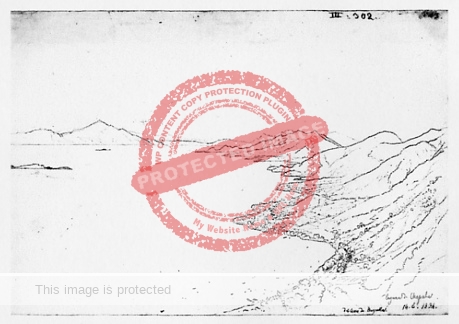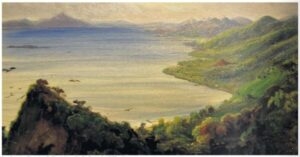The great German landscape artist Johann Moritz Rugendas traveled in Mexico from 1831 to 1834, much of the time in the company of Eduard Harkort. In January 1934, they explored the shores of Lake Chapala, and remarked on its “solitary and tranquil beauty”. During the trip Rugendas completed at least two sketches of the lake, having spent some time seeking the best vantage points.
These drawings (now in the collection of the Staatliche Graphische Sammlung in Munich, Germany) were the basis for two oil paintings of the lake: “Lake Chapala” and “View of Lake Chapala from San Jacinto hill”. (There may well be earlier paintings of Lake Chapala, but if so, they have yet to come to my attention. Neither Humboldt, who visited the area in 1803, nor Mrs Henry Ward, who accompanied her husband to Lake Chapala in 1827, is known to have drawn or painted the lake).
From Lake Chapala, the travelers went southwards towards Colima, where, among other accomplishments, they climbed Colima Volcano, and Manzanillo. In March 1834, Rugendas was jailed, and subsequently expelled from Mexico, for his involvement in a failed coup attempt against the then-president, Anastasio Bustamante.
Rugendas was born into a family of well-known painters and engravers and studied first with his father and then with Albrecht Adam before entering the Munich Arts Academy. Inspired by the writing and work of earlier German naturalists such as Johann Baptist von Spix (1781–1826) and Carl von Martius (1794–1868) Rugendas traveled to Brazil in 1821, where he found work as an illustrator for Baron von Langsdorff’s scientific expedition to Minas Gerais and São Paulo. Rugendas remained in Brazil until 1825, when he returned to Europe and published his monumental work Voyage Pittoresque dans le Brésil, which included more than 100 illustrations.
Rugendas had no sooner returned to Europe in 1825 than he met (in Paris) noted explorer and naturalist, Alexander von Humboldt (1769–1859), and was inspired to seek funding for an ambitious project to “become the illustrator of life in the New World”. In 1831 he traveled to Haiti, and then Mexico, where he executed numerous oil paintings. Following his expulsion from Mexico in 1834, he traveled through South America for more than a decade, returning to Europe in 1846, at the age of 44.
Rugendas’ superb drawings and paintings of Mexican landscapes, people and monuments were beautifully executed and helped give European viewers a glimpse into the geographic and cultural riches of the New World. Most of Rugendas’ works were eventually acquired by King Maximilian II of Bavaria in exchange for a life pension.
An exhibition displaying some of Rugendas’ paintings was held in the Instituto Cultural Cabañas in Guadalajara in July 1986.
Eduard Harkort (1797-1836) was a German mining engineer, geologist and cartographer whose journal “In Mexican Prisons: The Journal of Eduard Harkort, 1832-1834” (published by Texas A&M University Press, 1986) recorded his two years of fighting and imprisonment in Mexico.
Main sources:
- Gertrud Richert. “Johann Moritz Rugendas. Ein deutscher Maler aus der ersten Hälfte des 19. Jahrhunderts in Ibero-Amerika”, Ibero-amerikanisches Archiv Jahrg. 16, H. 3/4 (October 1942 / January 1943), pp. 67-94.
- Pablo Diener. Johann Moritz Rugendas: Bilder aus Mexiko. (1993)
Sombrero Books welcomes comments, corrections or additional material related to any of the writers and artists featured in our series of mini-bios. Please use the comments feature at the bottom of individual posts, or email us.
Tony Burton’s books include “Lake Chapala: A Postcard History” (2022), “Foreign Footprints in Ajijic” (2022), “If Walls Could Talk: Chapala’s historic buildings and their former occupants” (2020), (available in translation as “Si Las Paredes Hablaran”), “Mexican Kaleidoscope” (2016), and “Lake Chapala Through the Ages” (2008).

